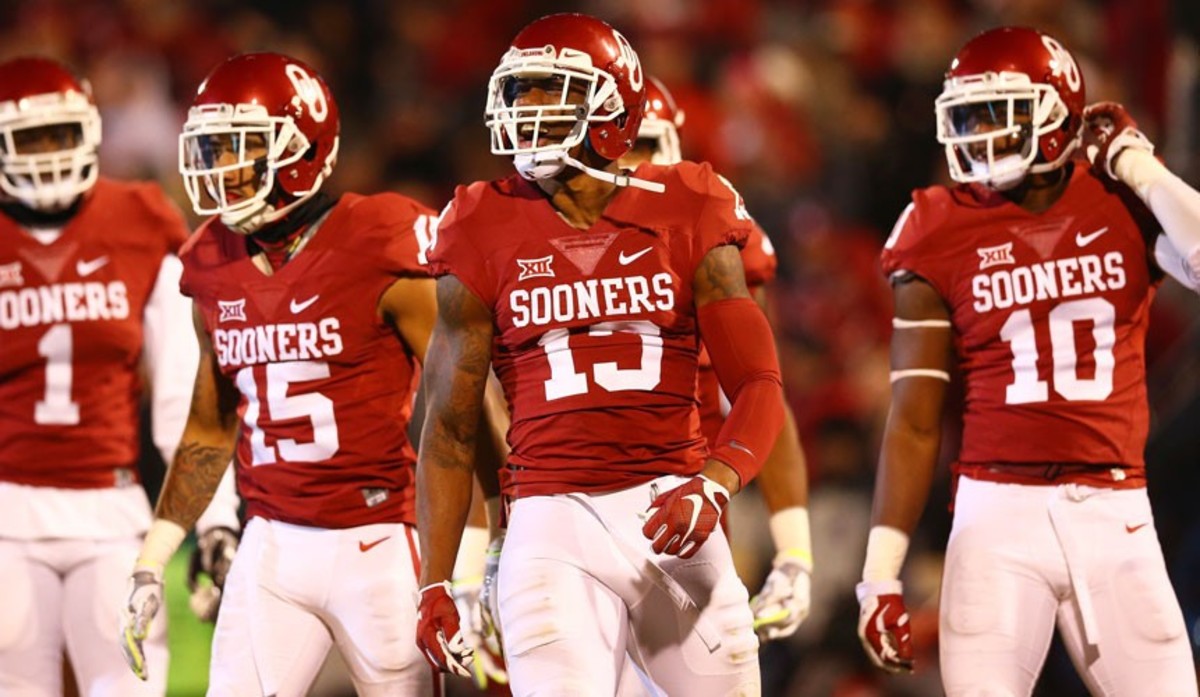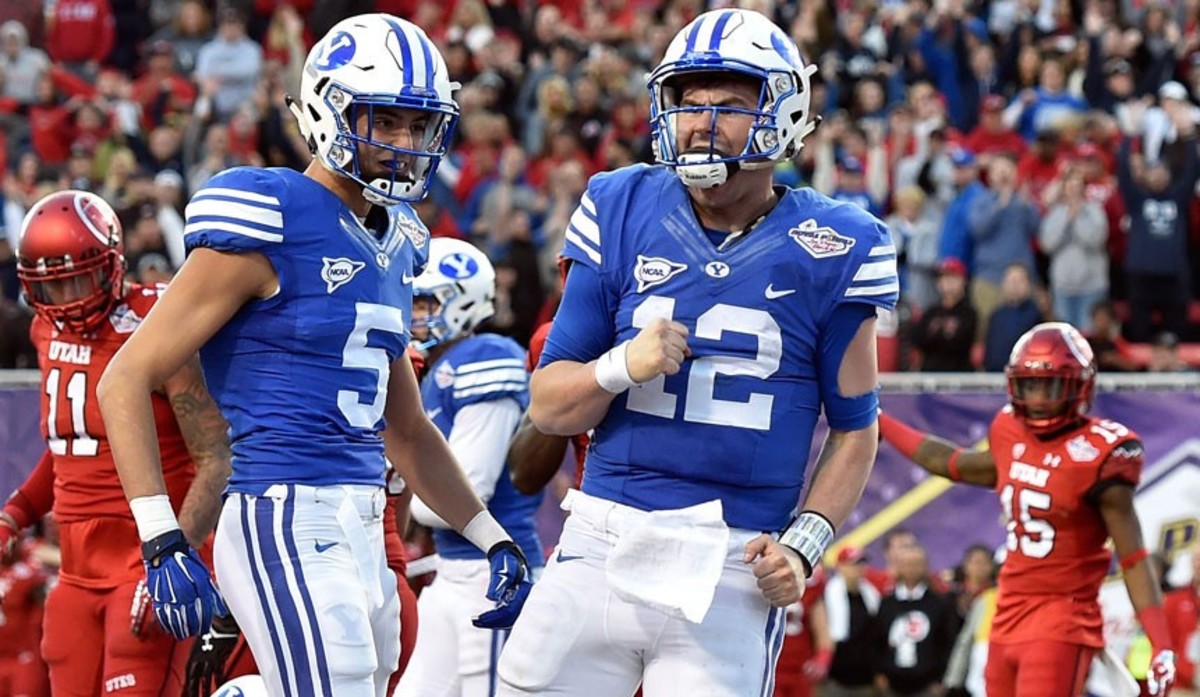Is the Big 12 set for major change or expansion? A look at the questions that will decide the league's future

FORT LAUDERDALE, Fla.—As Oklahoma arrived in South Florida this week for the Orange Bowl semifinal, it carried the hopes of the Big 12 with it. The conference hasn't won a national title in a decade and spent most of this season shrouded in uncertainty after getting shut out of the inaugural College Football Playoff.
The inclusion of Oklahoma (11–1) in this year's field has calmed the nerves of some around the league. But over the next three months the Big 12 will face crucial decisions that could result in significant changes.
The conference's small size (10 members), lack of a title game and absence of a cable television network all loom over the league's president and athletic director meetings in the next three months. The issues will come into clearer focus in January, after a vote at the NCAA Convention determines if the Big 12 can hold a title game while maintaining its current 10-team format. "I think the next few months are vital for us," Big 12 commissioner Bob Bowlsby told SI.com. "We'll begin to see a few more pieces of the puzzle and undertake a more thorough assessment of what our opinions are."
Bowlsby has stated all year that one season of getting left out of the playoff doesn't make a trend. But he cautions that two years doesn't make a trend either, admitting that the Big 12 lacking a "13th data point" in the form of a conference title game is "a disadvantage." The league will determine over the next few months how much of a disadvantage it truly is, and whether to make changes because of it.
The biggest question facing the league is philosophical: Is a bigger league actually stronger? Expansion is a potential step, and it appears that BYU and Cincinnati would be the favorites to be invited to the conference if it expanded today. However, if there were obvious and lucrative ways to expand the league and enhance revenue, the Big 12 would have taken those steps long ago.
With all that in mind, here's a breakdown of the issues facing the Big 12 after consulting with a dozen sources in and around the league.

Ronald Martinez/Getty Images
What is the current state of the league?
The Big 12 is as healthy and stable as it has been since four cornerstone schools—Colorado, Nebraska, Missouri and Texas A&M—departed during the last round of realignment more than four years ago. Texas's role as the domineering and divisive overlord of the conference seems to have faded, as it has endured a spate of administrative upheaval, football mediocrity and job turnover at nearly all of the key university positions. There's a party line that the league is much more in lockstep than it has been in the past. (And, well, it couldn't be any worse than the cauldron of petulance it was during the last round of realignment.)
The biggest issue hovering here will be whether the conference chooses to expand, something that will come into sharper focus in January (see below). From a macro standpoint, there's a general sense that the league is lagging behind its Power Five counterparts and is leaving potential revenue on the table. The Big 12 is the smallest of the power conferences, the only one without a championship game and one of two that lacks a television network. (The ACC is the other major league without a TV network.)
The benefit of having a smaller league is its round-robin format in league play, which coaches and athletic directors love. But remember, ADs have very little say in realignment. And coaches have none. Presidents and chancellors move the chess pieces, so it's important to remember that the league appears in perception to be lacking—lacking in size, lacking a championship game and lacking a TV network. Those could end up being driving forces for change.
The Big 12 has put together a Composition Committee, which is sometimes referred to in conversations as the Expansion Committee. The committee is headed by three presidents: Baylor's Ken Starr, West Virginia's Gordon Gee and Oklahoma's David Boren. Gee was a fervent expansionist in his Big Ten days at Ohio State, and given West Virginia's distance issues—it sits at least 800 miles away from every other Big 12 school—there is no reason to think he would be any less excited about potential expansion in this case. Boren has made his preference for a 12-team league public, saying the conference was "psychologically disadvantaged" at 10 members. Starr is more moderate, as Baylor is like many of the Big 12 teams—including Texas Tech and Kansas State—that favor the middle ground and want to explore all options.
Texas is still believed to prefer the status quo, but there's a feeling the new regime is much more sensitive to preserving the future of the league than the old one. (It would be hard for Texas to be less sympathetic to the Big 12 than the last regime was, though.)
What is the most important factor for the league moving forward?
The date Big 12 fans need to circle on their calendars is Jan. 15, as a vote at the NCAA Convention could provide a trigger for change. The 10 FBS conferences will vote on the Big 12's proposed legislation to waive the requirement that a conference can only stage a championship game if it has 12 or more member schools. For a few months, there was a general expectation the deregulation legislation would pass.
But the Big Ten added a wrinkle with a recent amendment to the Big 12's proposal. The amendment states that a championship game must be played between the winners of two divisions, meaning the Big 12 could only hold a title game so long as it also splits up into divisions. The rationale behind the Big Ten amendment is that it would prevent leagues from potentially manipulating the system by placing their top two teams into the title game regardless of division to increase their chances at landing a College Football Playoff bid. The thought from the Big Ten wasn't to stymie the Big 12 from having a title game with 10 teams, but rather to maintain consistency and avoid unintended consequences. (The amendment may be more targeted toward the ACC, which has floated some funky division formats.)
Right now, it appears the Big Ten and SEC would vote against the Big 12's initial proposal (before the Big Ten amendment), while the Big 12, Pac-12 and ACC would probably vote for it. (Considering how important this issue is to the Big 12's future, there has been surprisingly little creative thought behind it). The support for Big Ten commissioner Jim Delany's amendment isn't as clear, although the Pac-12 would likely be in favor of it to promote conformity.
The Power Five votes count for twice as much as the Group of Five's, but the smaller leagues could ultimately decide whether the legislation and amendment are passed.
Here's the prevailing thought around the Big 12: If its legislation proposal gets shot down, there's a roughly 70% chance the league will expand during the next year or two in order to get a title game. If the legislation passes, there's less than a 50% chance of imminent change in the form of the Big 12 adding new members. There are many other variables in play, but this is arguably the biggest.

David J. Becker/Getty Images
Which schools would the Big 12 add if it chooses to expand?
This is the sexiest question. The near-consensus is BYU and Cincinnati would be next in line if the Big 12 elects to expand. But the cruel reality is that if there were slam-dunk candidates to add value to the league, those schools would have already been added. There is a lot of collective remorse in the conference over not adding Louisville when it was begging to get in back in 2011. The Big 12 could have very easily added Louisville when it added West Virginia, as both were politicking hard to become members. (Pittsburgh was also on the Big 12's radar before it jumped to the ACC. It would be an upgrade over the current crop of candidates.) Now, West Virginia is alone on the eastern frontier with no natural neighbor or rival. Louisville moved to the ACC in '14, and the Big 12 lacks a clear choice that brings immediate value. Also on the table could be adding a school (BYU?) solely for football. At this point, all options will be discussed.
Here's an examination of the candidates listed in order of perceived attractiveness. Remember, the margins are slim, and the longer the Big 12 waits to expand the more potential there is for this order to change.
• BYU: The Cougars football program, which plays as an independent, has the most resonance of any available school. BYU has a national following and a decorated history that includes star quarterbacks Jim McMahon, Steve Young and Ty Detmer. There are issues with BYU, such as the BYUtv network, tough geography and some finicky logistics that come with not playing on Sundays. But those problems can likely be resolved, as BYU has an increased desire to join the league because of the yawning perception gap between the Power Five and everyone else. BYU realizes it won't be treated like Notre Dame as an independent, so this seems like the most logical move for both sides.
• Cincinnati: The Bearcats' best selling point is that West Virginia needs a friend and neighbor, and Cincinnati is just over 300 miles from Morgantown. The Bearcats offer the Cincinnati media market, a recruiting toehold in Ohio and strong recent success. The Bearcats have seven nine-win seasons since 2007 and played in the Orange and Sugar bowls in '08 and '09. Market and geography could win out.
• Connecticut: UConn came up in a surprising number of conversations considering its geography, lack of relevant football history and void of local recruiting. UConn would be attractive in a scenario in which the league adds a cable network, as it theoretically could bring a lot of eyeballs in the Northeast. The strong academics and basketball program would also be assets, as would the notion of the Big 12 adding a flagship state school. But if the conversation inevitably turns back to football, UConn wouldn't cut it.
• Colorado State: This would be another play for TV markets, as Colorado State would theoretically bring Denver. It would also help if the Big 12 adds BYU, giving the league a distinct footprint in the Mountain Time Zone. Colorado State's biggest problem is West Virginia, as the feeling within the league is that the Mountaineers have been good members and deserve a neighbor.
• Houston: To put it bluntly, the Texas schools in the Big 12 don't want to prop up another school located in the heart of their state's most fertile recruiting base. That line of thinking would likely win out over Houston's overall football potential, which is vast. There is surprisingly little momentum for the Cougars, as the prevailing thought is that the Big 12 already has a significant presence in the Houston TV market.
• Central Florida and South Florida: Considering the ripe markets (Orlando and Tampa) and boundless football potential, there is strikingly little momentum for these schools. Things could change, but neither is in the serious discussion now. (Someday, if the league goes to 14 teams, they might get more consideration.)
• Memphis: Memphis had some buzz for a while, as it features a solid television market and recruiting base. Ultimately, though, the football program isn't developed enough and better academic schools are available.
• Tulane: The New Orleans market would be attractive, as would the university's academic reputation. But the distinct lack of notable football history and the shadow of LSU have stalled Tulane's candidacy.
What are the chances of the league getting a title game?
Interviews with officials in other leagues and industry experts revealed that having a league title game in a Power Five conference can conservatively be estimated to bring in $20 million per year. (There are myriad variables: TV deal, marketing, ticket sales, sponsors, etc.) In the Big 12, that would mean $2 million annually per school. That's significant, as it could provide approximately $20 million to member schools in a decade.
Bowlsby has acknowledged that not having a title game is a perceived disadvantage. "It's just not possible to determine how much of a disadvantage it's going to be in any given year," he said.
Whether it's in a 10-team or 12-team league, odds indicate the Big 12 will likely have a title game by 2017. Ultimately, the decision should come down to whether the added revenue wins out over the fear of a title game keeping a team out of the playoff. (The guess here is, like usual in college sports, revenue wins out.)

Justin K. Aller/Getty Images
If the Big 12 added two schools—hypothetically BYU and Cincinnati—would its television contract grow enough to actually be worth more money?
The problem with the glut of unattractive candidates is there's a concern the league won't be able to keep the same share of television money if it expands. The general thought in the conference is that adding two teams would get the Big 12 close to where it is now revenue wise. (Big 12 teams project to get nearly $29 million in 2016 in TV money, basketball tournament revenue, bowl payouts and NCAA tournament money.)
Expansion wouldn't be some potential financial windfall, nor would it cost schools a ton of money. There are a lot of variables to this question, but the consistent answer is that the money would likely be close to what it is now from the TV deals.
Here's a wrinkle to keep in mind that will significantly impact potential new revenue streams: When the Big 12 got raided in 2010 and dropped its league title game, the conference's television partners essentially didn't charge them for lost inventory. If the title game comes back, there is an expectation that the league would still be able to get full value for the game. That's a big factor in keeping everyone happy.
Could the Big 12 start a television network?
As recently as two or three years ago, this conversation would have been a non-starter. Texas's Longhorn Network has a deal with ESPN that pays the school an average of nearly $15 million per year until 2031. It's impossible to have a league network without having the content from its top brand.
However, there's an increasing feeling around Texas that the Longhorn Network is trending toward a failure in every aspect other than its robust revenue stream. (ESPN has reportedly lost $48 million on the network, according to the San Antonio Express-News.) The Longhorns' mediocre teams have generated little interest in the programming, and some coaches are tiring of the network's demands considering its moderate reach. Texas football has done little to hold up its end of the bargain, as the team's 36–28 record since the network launched in 2011 has led to some of the programming being filled with criticism toward the Longhorns. That has turned off coaches and players and created an awkward dynamic. Coaches outside football still view the exposure as a positive in recruiting, which is unique and difficult to replicate.
Considering how disruptive the Longhorn Network has been to the Big 12, including helping drive Texas A&M and others away, there is some quiet glee around the league at its misfortunes.
One lesson from realignment is that no one is willing to give up money. (Less of a factor here is Oklahoma's television network, Sooner Sports TV, for its third-tier rights, which make an average gross revenue of $5 million per year.) But if the Big 12 could start a network that would keep Texas financially whole—promising it the same revenue as it brings in now—it may at least be willing to listen to the possibility. The Longhorn Network was the baby of former AD DeLoss Dodds and president Bill Powers. They are no longer at Texas, taking some pride and ego out of play. In these austere times for cable, however, would there be interest? A prominent Wall Street analyst recently downgraded Disney stock in part because of the high level of fixed costs due to sports television rights. (The New York Times published a fascinating article on this subject.)
As one industry source told SI.com: "Is it possible in this environment that new networks can get launched by anyone? You just sort of have to ask yourself, 'How realistic is all that?'"
Between the Longhorn Network issues and the cable climate, it's hard to envision any type of Big 12 TV network becoming more than barroom conversation over the next five years.
